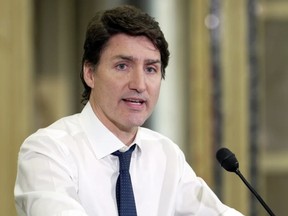Hiring more and more people to work for the government is unhealthy for our country’s economy

Article content
On the face of it, Friday’s jobs report was a good one – we added 90,000 jobs in April and the unemployment rate held steady at 6.1%.
Advertisement 2
Article content
But a deeper look at the numbers give cause to worry on two fronts.
Article content
Firstly, and most immediately, the 90,000 job gains and continuing increase in wages could give the Bank of Canada (BoC) pause for concern in lowering interest rates. The BoC’s next scheduled decision on whether to raise, cut or stand firm on the teen setting overnight rate comes on June 5 – a little over three weeks from now.
Several analysts reacted to the hot jobs numbers with concern that the BoC would hold off on cutting rates from the current 5%. The sharp increase in rates over the past two years has exacerbated the housing crisis, increasing costs for average Canadians but also slowing new housing construction at a time when it is desperately needed.
If the BoC holds firm over concerns that inflation isn’t yet fully under control, it could further hurt housing starts and private sector hiring. Which brings us to the next problem in the job report, Canada’s job growth of late has all the stability of a house of cards.
Article content
Advertisement 3
Article content
The majority of the 90,000 jobs created last month were part-time – 50,000 part-time to 40,000 full-time – and 28% of the job growth was in the public sector. What’s worse, once again, the economy failed to keep pace with population growth, something Statistics Canada has been warning about for months now.
StatsCan has said in the past that we need an average of 50,000 new jobs being created each month to keep up with our immigration-driven population growth and we simply aren’t getting that. Even last month, the 90,000 jobs created didn’t keep pace with the 108,000 people who entered the labour force.
Recommended from Editorial
-

LILLEY: Trudeau’s out-of-control immigration hurting jobs and housing
-

LILLEY: Trudeau policy change on Israel rewards Hamas terrorists
-

LILLEY: Rate stays put as Bank looks for clarity on Canada’s economy
Advertisement 4
Article content
Compared to last April, Canada’s working population aged 15 and over grew by 3.3% from 32.2 million to 33.3 million last month. Employment though only grew by 1.9% over that same time frame from 21.1 million to 21.8 million.
Over the last year, the number of people looking for work but unable to find any has increased by 256,000 to 1.3 million people. A year ago, Canada’s unemployment rate was 5%, today it’s 6.1%, and it would be higher if not for the explosive growth in public sector employment, a trend that is simply not sustainable.
Of the 398,000 jobs created across the country over the last 12 months, 208,000 (or 52%) have been in the public sector.
A month ago, Prime Minister Justin Trudeau acknowledged that his government has increased the level of immigration, especially foreign students, “at a rate far beyond what Canada has been able to absorb.” This is the major factor in the increase in the unemployment rate over the last year and that unemployment rate would be much higher without the staggering increase in the number of government workers.
Advertisement 5
Article content
Between April 2023 and last month, the labour force grew by 3% but the public sector workforce grew by 5%. The disparity in growth between 2019 and 2024 is even more startling with the country seeing an 8% growth in the labour force and a 16% growth in the size of the civil service.
Canada’s economy won’t be a healthy one if the job growth continues to be led by more and more people working for the government. Yet, there are two things that the Trudeau government won’t cut, beyond spending, and those are immigration numbers and government jobs.
Canada’s economy is not collapsing, we aren’t in a recession, but there are plenty of signs that we aren’t in a healthy state at the moment.
Article content









